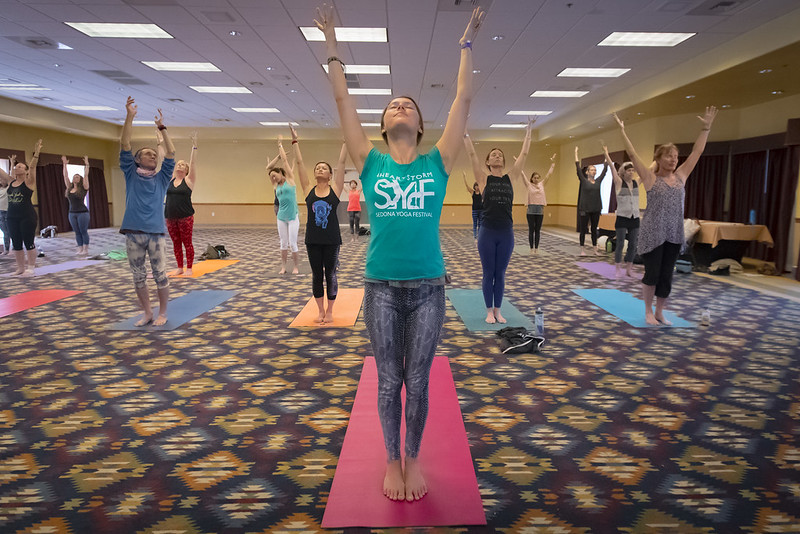
Apr 18, 2023 | Programming Spotlights, Sedona Yoga Festival Teacher Feature
A Yoga Hug to Midline
By Donna Schnoor, E-RYT500/YACEP owner of Yoga4Ullc
Lead image by Arin Pitcher
As yoga practitioners, most of us have heard the term sthira sukham asanam. It is one of the most often quoted aphorisms in Patangali’s Yoga Sutras, (2.46). In general translation it stands for steadiness and ease in your seat. So what does all this have to do with the term “hugging to midline”?
The “midline” is the imaginary vertical axis that bisects the whole body, from the crown of the head all the way down to the foundation. If you’re familiar with construction, think of it like a plumb line. In Yoga think of it as the Sushumna, the vertical axis or channel in the subtle body where your pranic energy flows. The midline is the foundation in which each posture is built.
Physically drawing or (hugging) into the midline will help make your practice stronger and more stable. Instead of using the outermost muscles to support the pose, we learn to engage the deep inner muscles, so the pose starts from the inside out, rather than the outside in.
On an emotional and spiritual level, finding your midline helps us to find that inner strength and stability to cultivate balance in our lives. This balance between action and stillness, or steady and comfortable. This balance supports you from the inside, just as the physical action of muscles hugging to midline supports our bodies in practice.
Eckart Tolle speaks of “feeling the inner body as a way of connecting to the present moment”.
When we come to our first seat of practice, we find our own physical space, we turn inwards to access something deeper within ourselves in which to build our practice.
As we start to move, we begin to learn to ‘hug-in’, to firm the muscles around the bone, to create a strong and stable foundation in our practice.
Learning to ‘hold our center’ gives us the support we need when being pulled off balance with life’s experiences, whether they be physical, emotional, or mental.
When we reach Savasana, our opportunity for relaxation and integration, we find our center once again, both physically and mentally, and from this center we can experience a sense of letting go.
Explore your midline and the foundation for functional asana with Donna at SYF2023, April 27–30! Passes are available here.
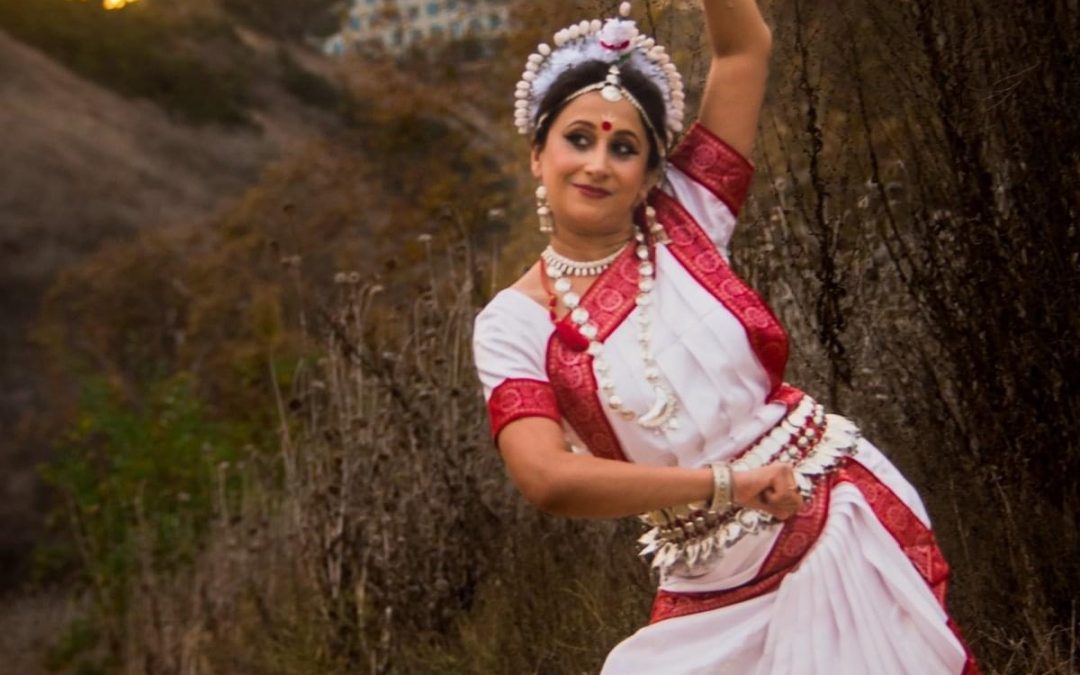
Apr 18, 2023 | Programming Spotlights, Sedona Yoga Festival Teacher Feature
Role of Odissi Movements in Trauma Healing
by Nilanjana Banerjee, RDM Studio
Lead image by The Dreamy Pomgrn8
Odissi is a 2000-year-old dance from Eastern India. This dance is rooted in yoga, bhakti and spirituality. It connects the human spirit to the divine and was performed for centuries inside the temples by female dancers. These women were the equivalent of the priestesses in the temples using powerful Sanskrit mantras and dance movements to worship and invoke the Gods and Goddesses.
Dance movement is another somatic modality like yoga, breathwork, meditation and sound bath to open up your chakras, and create more space specially in your ribcage, and hips. These are areas in the body that are most stuck in todays modern world.There are senescent cells that form when someone undergoes trauma that holds onto the memories within their cells. It’s like they are frozen in time.
Odissi dance movements are unique in the sense that there is a significant movement of the neck, rib cage and opening of the hips. According to Dr Mima, who specializes in mind body connection,
“As a woman in modern day life, you spend very little time on these areas and in fact sitting at desks, driving cars actually keeps the hips and ribs closed. Over time this constricts proper airflow and the energy within the sacral chakra. By opening the hips and ribs in this dance you increase blood flow to your sacrum and oxygenation to your lungs and chest organs. Dancing barefoot also connects the body with earth’s energy. The earth carries an electromagnetic field and when we connect barefoot with the earth we literally ground our energy and rebalance ourselves. This relieves anxiety and stress and also helps rebalance the adrenal and endocrine glands in the body.”
Both masculine (shiva) and feminine (shakthi) energies are addressed in this dance. Once the strong masculine moves and softer feminine moves are mastered, the dancer begins to internalize the moves and their meaning. This is very similar to meditation. In dance you not only connect with yourself in flow, but you are also connecting with the divine. There is deep healing when this occurs.
Nilanjana says, “working with numerous adult students, over a period of time I realized the power of my dance, how I was not only teaching them an ancient art but also healing them with my energy, giving them the power and confidence of a Devi. Be it physical injuries or deep emotional trauma, most of their traumas came to the surface during the course of my regular teaching. There was an emotional release and sometimes continuing the practice helped many deal with traumatic life situations, empowering them to find and embody the strength of the Gods/Goddesses and even transform their outcomes to a point of reaching bliss. Of course this takes time, dedication and practice. But it’s the discipline and commitment that makes all the difference.”
It is believed that one can access the Anandmaya kosha by regularly practicing this dance and being immersed in this sadhana.
Please join Nilanjana and RDM Studio for Trauma Workshop 8.00 am on Friday April 28th and an upcoming dance performance at SYF2023. Passes are available here!
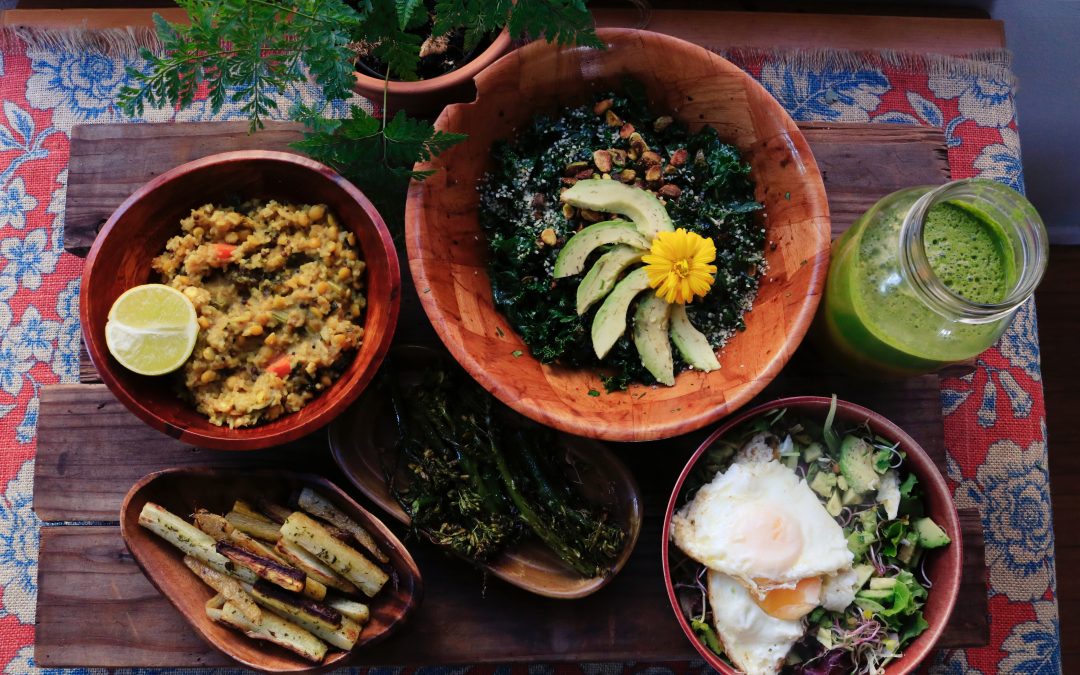
Apr 18, 2023 | Programming Spotlights, Sedona Yoga
Ayurveda — The Big Bang of Medicine
by Judyth Shamosh, Ph.D., Systems Herbalist
Ayurveda
A philosophy for perfecting
through the art of the heart,
the timeless Truths of millennia
balancing Beauty
and graceful Goodness
to manifest our material matter
in harmony and healthful rhythm
to understand the Universe
to understand ourselves.
~J. Shamosh
Ayurveda is the earliest form of medicine on our planet originating in India well over 5000 years ago. It was, at first, a Vedic oral tradition before it was eventually written down. From northern India, the knowledge and wisdom of Ayurveda spread and was modified as it expanded throughout the world. Ayurveda is the Big Bang of medicine.
Ayurveda for over 5000 years has continually valued what modern physics has shown to be reality—the foundation of life is consciousness and body or energy-matter, but the essence of life is the spirit-awareness, the “heart of matter” –part of the living cosmic web of life. Our lives are physics and poetry, matter and expression, context and awareness. It is this fundamental understanding and wisdom of all aspects of life that renders Ayurveda so valuable in maintaining our health.
The vital science and system of Ayurveda provides guidance for living in harmony with our inner, microcosmic, and outer, macrocosmic, environments as well as other beings around us. Ayurveda’s way of teaching us is very poetic, because life is poetic, with much more going on between the lines than is readily apparent by just the material facts themselves.
Ayurveda is unique in that it clearly informs us how to live in harmony with Nature. One may call it the original ecological worldview where the fundamental interdependence of all living systems is primary. Ayurveda encompasses all aspects of life—our physical bodies, our thoughts and emotions, our spiritual connections, our relationships and inter-relationships to each other and the other living systems in our environment. Ayurveda teaches us how to maintain a dynamic harmony with these concepts to maintain and regain our health.
The Five Phases of Ayurveda precisely and poetically, describes the energetic processes that are inherent in the energy and matter of our bodies. The actions and experiential effects of the Five Phases transmit the chemical actions or potency of herbs and foods into our bodies to help us heal and maintain our health. Ayurveda’s foundational theory of the Five Phases combine in different ways to constitute our doshas. Learning the roots of the Five Phases gives us a more profound understanding of our doshas.
Explore more Ayurveda techniques, recipes, and foundational philosophy with Judyth and many more at SYF2023 April 27–30! Passes available here.
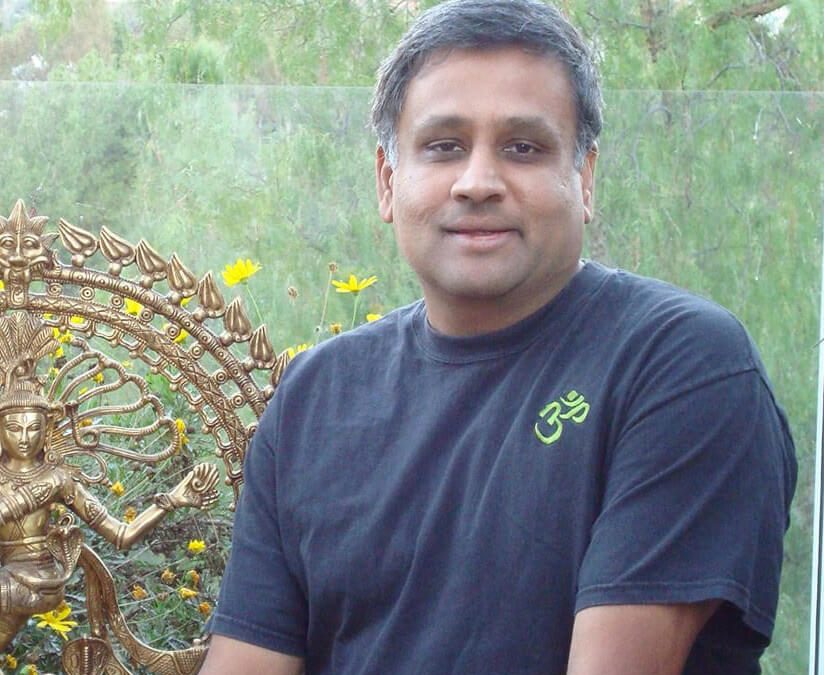
May 2, 2022 | Programming Spotlights, Sedona Yoga Festival Teacher Feature
Telling stories is Manoj Chalam’s calling. He started importing Hindu statues to the U.S. 21 years ago, and it wasn’t long before the job morphed into one that would end up defining his life. Manoj currently has the largest collection of Hindu statues in the country — but it was after a stint at an ashram in San Diego that he realized that it wasn’t about the object itself, but the story they represented. “There’s a reason that oral traditions exist,” he says. “If I just tell you facts and figures of philosophy, two areas in your brain will light up. But if I tell a story, 20 areas of the brain light up,” he says. It’s the psychological reason that storytelling is so compelling.
Sharing the stories symbolized by iconography that is standard in yoga studios and on festival stages alike is Manoj’s life work, a task he approaches with humor and panache. “Some people call me a spiritual standup comedian,” he says. “I have a little bit of an edge because I’m brown, fat, and have an accent. Humor puts people at ease — it’s how they get into the flow state,” says Manoj. He holds a PhD from Cornell in Chemical Physics, so he’s no stranger to science. The science behind getting people into the flow state allows his listeners to truly engage with the archetypal stories that he shares.
“There’s the symbol of these statues and their archetypes” says Manoj, “then there’s a universal mythology, and then a personal mythology of every one of us.” This triangulation of his storytelling allows Manoj to guide people toward an “aha” moment, which that allows them to find what the archetype is, and what it means personally for them.
Why Decoding Archetypes Matters
Understanding the archetypes of Hindu mythology is helpful not only to understand the roots of yoga, but also because these kinds of myths help us get at the root of who we are as individuals, and how we show up in society. They help us understand the importance of doing the “real work,” rather than hiding the shadows behind the guises of meditations and chanting. “I’ve seen a lot of yogis engaged in what’s called spiritual bypassing,” says Manoj. “Teachers who are pretending that everything is joy,” for example. “One has to realize that being human means we all have a shadow.”
As does everyone, yogis need help addressing the shadow within. Manoj’s teachings integrate the idea of shadow work through the discussion and dissection of archetype theory. He brings psychologists into his workshops in order to take the presentation of mythology a step further. This kind of intentional storytelling allows not only for the investigation of the myths behind the practice, but how they may inform and show up in our own lives.
“I’ll help people find what their archetype is, and then what the symbols mean,” says Manoj, a practice that is very common with yogis in India, called samatha meditation. “You meditate in front of your archetype — the statue — and the statue is a portal to the infinite,” he says. This type of meditation and mantra opens the eyes to one’s own archetype. This contextualizes a person’s experience within a broader whole. And of course, “the context changes because your life situation changes. So these archetypes can change in your life with time,” he says.
Using Archetypes as Vehicle Toward Enlightenment
“The mind is very susceptible,” says Manoj, “it’s like a vacuum that sucks in all the energies of these symbols.” The goal of this kind of archetype rumination — like so many yogic practices — is to find a calm mind. “The same mind that can wander all over the place can be a vehicle for enlightenment,” says Manoj. Understanding how to use these archetypes as a focus for meditation and mantra is one way to release thoughts, and encourage the cultivation of a calm mind.
“The space between your thoughts is who you really are,” says Manoj. “Let the thoughts come,” he says, “and each time you chant, it’s like a windshield wiper that wipes the thoughts clean. Each time you do so, the gap increases, and your mind is able to open to your archetype.”
Experience this kind of deep teaching with Manoj in person at SYF this April! Tickets on sale now.
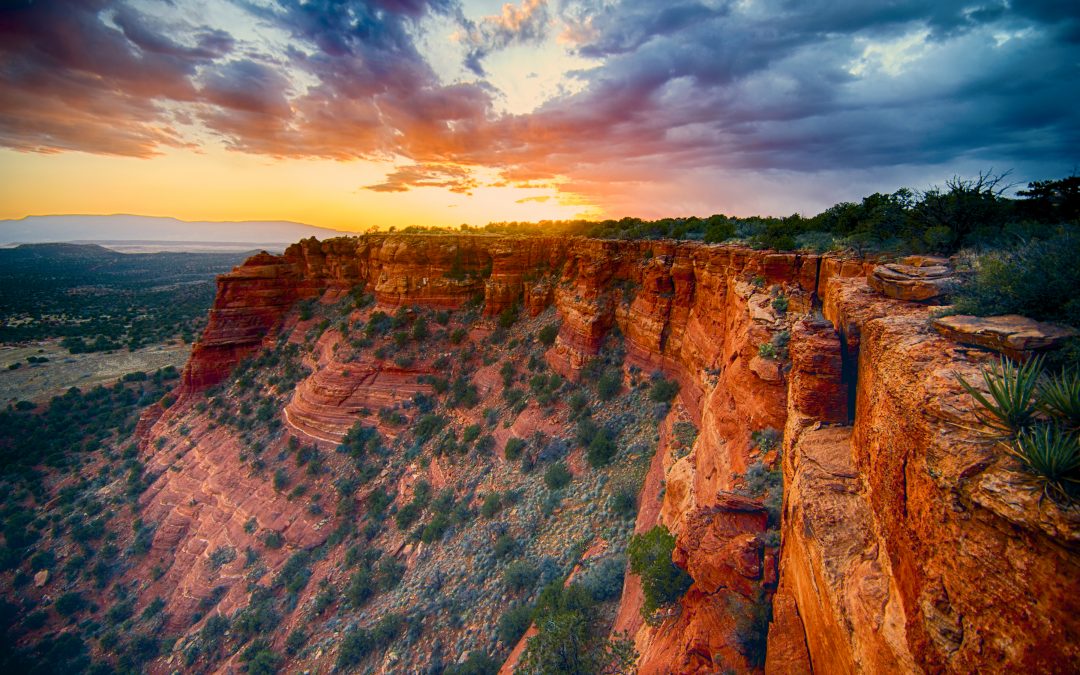
Apr 27, 2022 | Programming Spotlights
On-The-Land Excursions offer a unique way to experience the majesty and energetic beauty of Sedona — an opportunity you’ll only find at the Sedona Yoga Festival. We’re proud to partner primarily with local guides to share with you the transformational landscape of this incredible place we call home. Read on for more information about your 2022 Excursions, and then book your ticket today! https://bit.ly/SYF22Tix
Huckaby Trail, led by Roxanne Wessel
Explore Bear Wallow Wash and expansive views of Oak Creek and Uptown Sedona, replete with many of the tourist-book red rock formations of the area. You’ll meander creekside in the partial shade of Riparian Trees.
Summit Trail, led by Alan Alcid
This intermediate hike will get you the sweeping vistas of the energetic red landscape that Sedona is known for. You’ll adventure in and out of wilderness areas, and have the opportunity to engage with the wildlife of Sedona’s desert biome. It’s not an easy ascent, but the views are worth every breath.
Red Rock Crossing/Crescent Moon Ranch, led by Sharon Day
This is an easy trail that awards sweeping vistas of famous Cathedral Rock. You’ll also get an unobstructed view of Red Rock Crossing Vortex, and the trail is family and wheelchair friendly for all guests.
Red Rock Crossing (Second Approach), led by Taylor Kurz
A different approach to this iconic hike, coming in from a more secret / “locals-only” location.
Cathedral Rock, led by Kim Sieb
If you know nothing else of Sedona’s famed landscape, chances are you’ve seen Cathedral Rock portrayed in countless movies etc. Get up close and personal with this landmark, and experience it surrounded by mindful community.
Lead photo by Dexx Creative Imagery
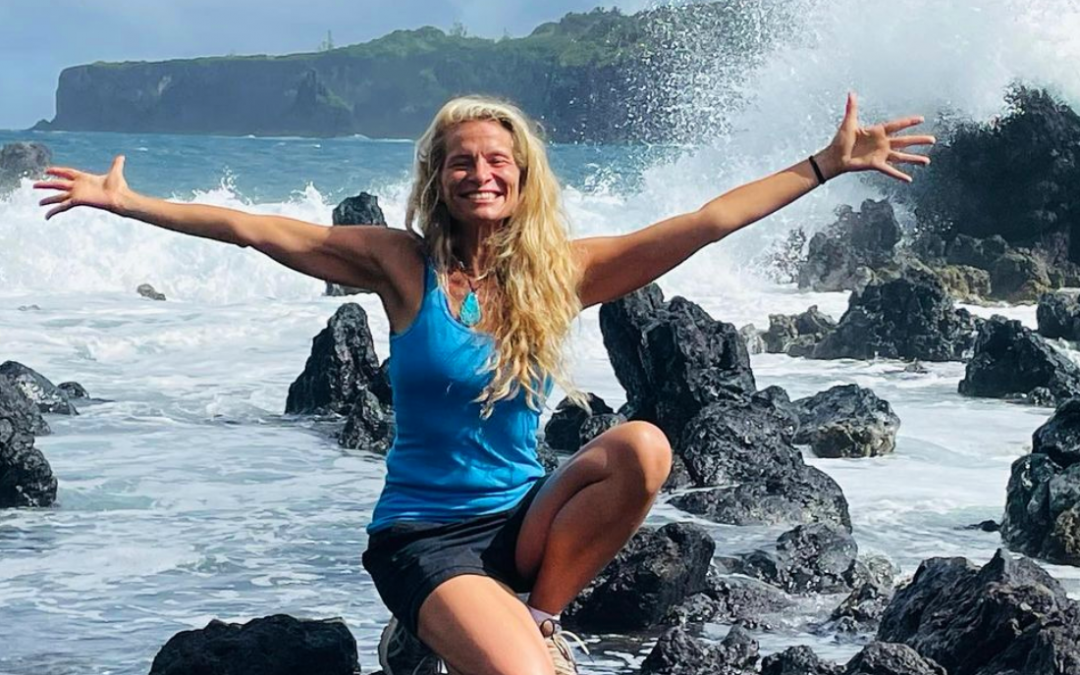
Apr 14, 2022 | Programming Spotlights, Sedona Yoga Festival Teacher Feature
For SYF presenter Janet Farnsworth, it’s all about the physical body. As a somatic therapist and body empowerment coach, Janet believes that facilitating a meaningful connection with our bodies is crucial to creating an empowered relationship with the self. “Your body is the best of you,” she says. “Your body, and how your body holds you at every moment can teach you, and is actually your access to grace.”
In a world in which we’ve been taught so many things about what our body is, what it “should” be, and how we move into it, this can be a difficult concept to impart, or to grasp. “Many of us have very real experiences that separate us from our bodies,” acknowledges Janet. This is true regardless of our experience with trauma, or how much yoga and meditation experience we have. Our so-called “monkey mind” is relentless. Janet specializes in helping people have a consciousness shift that the body is not its appearance, but rather the experience that it gives us.
Janet believes that the body is the voice of the soul — which is at first a confusing thing to hear a yoga instructor say. “I know there’s a lot of subtlety in that,” says Janet, “but I also believe that the divine loves a paradox, right? We are not our bodies, but I’m here to speak for the bodies that we are. What I do is help us figure out how to make being in our bodies the most peaceful, awake experience it can be. I specifically do that with women, and some of the stories that we have about what our bodies are.”
How Being In Our Bodies Creates Presence in Grace
In Janet’s perspective, as our bodies are temporary homes for our infinite souls, they present an opportunity for us to be in divine communication, and a connection to one of the most valuable conduits to grace. “It’s a gateway to bridge the divide,” she says. Though there’s often an eagerness to leave the body behind, developing that conduit can actually be a helpful way to access deeper connection.
As such, SYF attendees can expect to walk away from Janet’s classes with a new relationship to their bodies, or a different way of looking at relationship with their body. But it’s more than that — it’s also to create the ability to, say, stand in front of the refrigerator and not feel afraid; the ability to walk by a mirror and look in it. It’s a shift to appreciate the body that you’re living in, every moment of every day.
And when we do that, says Janet, “then a relationship to our sexuality changes completely. The ideas that I’m specializing in right now involve how we relate to our bodies, and how that relates to our sexuality.”
The SYF Experience
Janet is no stranger to the Sedona Yoga Festival, and is excited to return because she says that SYF “holds an extraordinary container for love and truth.” She calls it a consciousness-raising experience, which is a phenomenon that Janet experiences — and again, helps other people experience — through their physical bodies.
“I think that the body is brilliance,” she says, “I think that the body is the voice of God; it’s our own God. I’m thrilled to share one small thread of what’s possible about connecting to grace and living in grace.”
Experience your body in a whole new light and practice with Janet in person this June! Tickets on sale now: https://bit.ly/SYF22Tix







